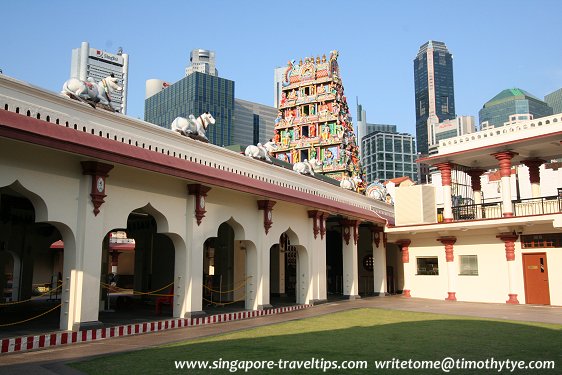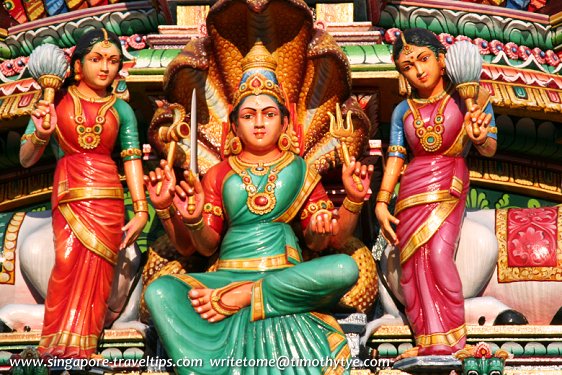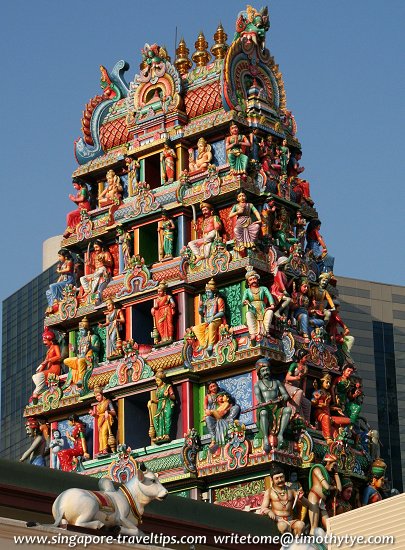 Sri Mariamman Temple (12 September, 2010)
Sri Mariamman Temple (12 September, 2010)
Sri Mariamman Temple (GPS: 1.28274, 103.84512) at , is the oldest and biggest Hindu Temple in Singapore. It is located in the Chinatown neighbourhood of Outram, Singapore. It was founded in 1827 by Naraina Pillay (variously written as Naraina Pillai, Narayan Pillai, Narayana Pillay), a clerk of the British East India Company who arrived in Singapore from Penang aboard the same ship that carried Stamford Raffles.
Settling down in Singapore, Naraina Pillay started several businesses including a brick kiln and a cotton trading company. He sought from the British authorities a piece of land to build a Hindu temple. At first he was offered a site along Teluk Ayer Street, which was then beside the bay. However, the site did not have fresh water.
William Farquhar, the British Resident of Singapore, then suggested a plot along Bras Basah Road. Eventually, the Town Planning Committee determined a site along South Bridge Road, and in 1823, Naraina Pillay began his temple.
 Sri Mariamman Temple (12 September, 2010)
Sri Mariamman Temple (12 September, 2010)
Initially, the Sri Mariamman Temple was only a small attap hut with the small statue of the deity, called Sinna Amman, in the main sanctum. This small statue is still there in the main sanctum today. It was originally known as Mariamman Kovil and later on as Kling Street Temple. Later on, the temple was expanded when an Indian landowner Seshasalam Pillay donated some land to it.
The attap hut was replaced by a brick building in 1843. It was constructed by ex-convicts from Madras who happened to be skilled craftsmen. Funds came from Indians who settled in Singapore from Nagapatnam and Cuddalore districts of South India. It was dedicated to the goddess Mariamman, whom the Hindus believed has the power to protect them against disease and death. The temple also became a place for newly arrived immigrants from South India to find shelter before they could get permanent living quarters. Being a temple built by the South Indians, the Sri Mariamman Temple was built in the South Indian Dravidian style.
The temple building that we see today, complete with its intricate sculptures, date from only 1962. Its most outstanding feature is the gopuram, or grand entrance tower. The original gopuram built in the 1800's was much more plain in design.
The earliest consecration ceremony, or kumbabishegam, of the Sri Mariamman Temple, according to temple records, only date to June 1936. The second was held in 1949. Subsequently, kumbabishegams were also held in 1971, 1984 and 1996.
Visitors may enter the Sri Mariamman Temple at any time of the day, but the best visiting hours are between 7am to 12 noon and 6pm to 8.30pm. While entrance is fee, you need to purchase tickets for bringing in still and video cameras. And of course, you should enter barefooted. On the doors are many bells which devotees will ring with the belief that doing so will make their requests be granted. During the Theemidhi festival, which occurs somewhere in October or November every year, you may get to watch the amazing fire-walking ritual. An interesting trivia is that Pagoda Street, the road just beside the Sri Mariamman Temple, was erroneously named because the British authorities mistook the gopuram of the Sri Mariamman Temple for a pagoda.
The Sri Mariamman Temple was gazetted a National Monument of Singapore on 6 July 1973.
Address
Sri Mariamman Temple244 South Bridge Road,
Singapore 058793
Getting there
The nearest MRT station to the Sri Mariamman Temple is the Chinatown MRT Station (NE4).Sri Mariamman Temple is  on the Map of South Bridge Road, Singapore
on the Map of South Bridge Road, Singapore
Sri Mariamman Temple is  on the Map of Hindu Temples in Singapore
on the Map of Hindu Temples in Singapore
 Sculptures at the Sri Mariamman Temple (12 September, 2010)
Sculptures at the Sri Mariamman Temple (12 September, 2010)
 Gopuram of the Sri Mariamman Temple (12 September, 2010)
Gopuram of the Sri Mariamman Temple (12 September, 2010)
List of the Hindu Temples in Singapore; Discover Singapore
 Copyright © 2003-2025 Timothy Tye. All Rights Reserved.
Copyright © 2003-2025 Timothy Tye. All Rights Reserved.
Copyright © 2003-2025 Timothy Tye. All Rights Reserved.

 Go Back
Go Back